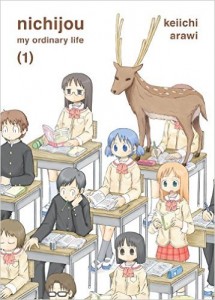By Keiichi Arawi. Released in Japan by Kadokawa Shoten, serialized in the magazine Shonen Ace. Released in North America by Vertical Comics.
I have a weakness for gag manga, as some of you may have noticed, and also a weakness for high school slice-of-life starring a bunch of quirky high school girls. It should be no surprise, therefore, to learn that I have been awaiting the release of Nichijou for some time. It was initially licensed by Bandai Entertainment about 5 years ago, but they folded their US manga division before it could even get a volume out. That said, the anime did appear over here, and was quite popular – in fact, arguably far more popular than it ended up being in Japan. And so Vertical, which has been dipping its toes into the surreal gag world with titles like My Neighbor Seki, now introduces us to a very unordinary manga.
Nichijou has quite a large ensemble cast, but for the most part is the adventures of five girls. Three of them, Yuuko, Mio, and Mai, are classmates at the local high school. Yuuko is peppy, somewhat dense, and very fond of attempting to make jokes that no one finds funny but her. Mio is the “normal” girl in the csat, but that’s only a matter of degrees, as we discover when she realizes her secret yaoi manga doodle is about to be discovered and becomes Superwoman. Mai is my personal favorite, a quite and shy girl who loves to bait and get reactions from Yuuko, I suspect as it’s the only way she can really show her feelings. There are apparently fans of Nichijou who dislike Mai for her gadfly nature, but these people are objectively wrong, so there’s no need to worry about them.
The other two main cast members are Nano, a robot girl who also attends class and her child genius inventor Professor, who’s a genius at making robots but an immature child in almost every other sense. Those familiar with the anime might be taken aback by Nano appearing in class right away – the anime decided to move all the stories with her in class to the second half of the series, the better to separate the ‘school’ and ‘Professor’s house’ segments of the show. We also meet a few other amusing minor characters here, like the farmer’s son who acts like a stereotypical rich boy, and the parody of tsunderes who can be seen literally blowing people’s brains out (though they’re fine a panel later – this is essentially a cartoon, in the Western Looney Tunes sense).
There’s not a lot to review in Nichijou beyond the gags, which I don’t want to spoil if you haven’t seen them. As with most manga of this sort, the humor can be found in facial reactions, and Arawi is very, very good at these – check out Chapter 9 for the best example. The girls are cute as well, but there is a blissful lack of fanservice that I also greatly appreciate, and there don’t seem to be any obvious romances besides the one-sided crushes Mio and the tsundere parody have. Nichijou is content to make jokes and be strange, and if it has to choose between being funny or being strange, it will pick the latter. If you like laughing, or if you like tilting your head and going “wuh?”, either way you’ll enjoy this.


The anime cracked me up consistently, so I”m looking forward to the manga!